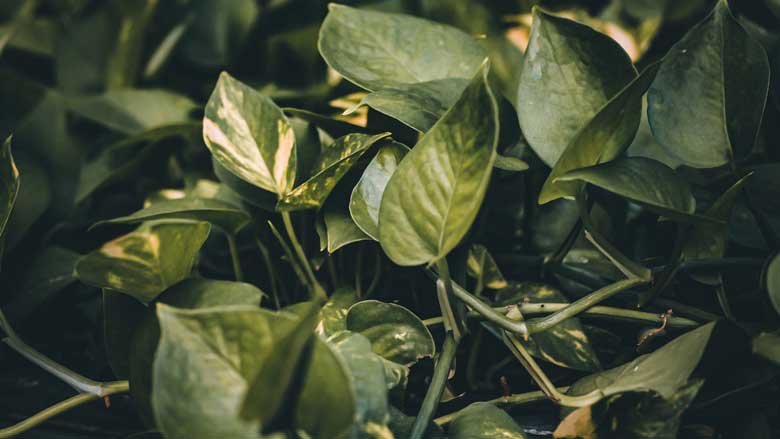The most common reason that can cause a Pothos plant to turn brown is improper watering. Watering issues can cause the leaves to start turning yellow and then brown. If you’re giving your pothos too much water, it will eventually drown and rot away. On the other hand, if you’re not providing enough water for your pothos plant, its leaves will turn brown from dehydration.
Pothos plants are beautiful, easy-to-care-for houseplants. They can tolerate a wide range of growing conditions and are relatively drought-tolerant.
However, even the hardiest of plants can experience problems from time to time.
One problem you may encounter with your Pothos is leaves that turn brown.
If your Pothos leaves start to turn brown, it could be a sign of distress, indicating that the plant is not getting the proper care or environment it needs to thrive, and it is important to take the necessary steps to address the issue as soon as possible.
There are several reasons why your Pothos may turn brown.
However, before we get into the reasons, it’s essential to understand that brown Pothos leaves are not always a sign of a problem.
For example, older leaves may naturally turn yellow or brown and drop off as new growth appears. This is perfectly normal and nothing to be concerned about.
However, if you notice that your plant is losing a lot of leaves or the leaves are turning brown and crispy, this could be a sign of a problem.
In this article, we will explore the possible causes of this problem and provide solutions so you can get your pothos plant back to good health.
Why Are My Pothos Leaves Turning Brown?
One of the most common problems that Pothos owners face is browning leaves.
There are several reasons why your plant leaves might be turning brown, and thankfully, there are just as many solutions.
Let’s look at some of the most common causes of browning Pothos leaves and what you can do to fix the problem.
1. Too Much or Too Little Water
One of the most common reasons for Pothos brown leaves is improper watering.
Plants are susceptible to too much and too little water, and either can cause the leaves to turn brown and crispy.
An underwatered Pothos will have wilting, dry, and brown leaves. Also, the leaves will feel papery, and the stems will be weak and limp.
An overwatered Pothos will have leaves that are brown and mushy. The leaves will also fall off the plant easily, and the stem will be soft and spongy.
How To Fix It
If you think you are watering your Pothos too much or too little, the first step is to check the soil.
Stick your finger about an inch into the soil, and give your plant a good drink if it feels dry. Hold off watering for a few days if the soil is soggy or muddy.
When the soil is dry to the touch, you should water it, but be careful not to overwater it, as this can cause the soil to become too soggy or muddy; instead, it should be slightly crumbly, with just enough moisture to keep the plant healthy.
Investing in a moisture meter to check the soil without sticking your finger in it every time is also a good idea. This will help you monitor the moisture level and water your plant accordingly.
Another way to fix this problem is to change the type of potting mix you are using.
If you are using a potting mix that drains poorly, it could cause your plant to stay too wet.
Switch to a potting mix with good drainage; you should see a difference in your plant’s health.
To improve drainage, you can also add perlite or vermiculite to your potting mix.
Make sure you don’t add too much, or your potting mix will be too light and dry out quickly.
Pothos plants need to be watered every one to two weeks and allowed to dry out completely between waterings.
If you still have trouble with brown leaves, try watering with distilled water or rainwater. This will help remove any chemicals or minerals in your tap water that could be causing the problem.
2. Too Much Sun
Pothos plants are very tolerant of low light conditions but will experience problems if they get too much sun.
Too much sun can cause the leaves to sunburn and turn brown and crispy.
Sunburned leaves will have brown patches that are dry and papery to the touch.
They will also be curled up or distorted in shape, and the edges will be brown and crisped.
How To Fix It
If your Pothos is getting too much sun, the best solution is to move it to a spot with less direct sunlight, as too much heat can cause the leaves to become scorched and the plant to suffer from dehydration.
These plants do best in bright, indirect light, so try to find a spot where your plant will get plenty of light without being in direct sunlight.
An east or west-facing window is usually the best spot when growing Pothos indoors.
If you can’t find a shadier spot for your plant, you can also try to create shade by hanging a sheer curtain over the window.
Ensure the curtain is lightweight and doesn’t block out too much light.
They can also be grown in artificial light. If you can’t find a spot with enough natural light, you can try increasing your plant under fluorescent lights.
Keep the lights on for at least 12 hours daily to give your plant enough light.
3. Temperature Stress
Pothos plants are very tolerant of a wide range of temperatures. Still, they can experience problems if the temperature gets too hot or too cold.
If the temperature gets too hot, the Pothos leaves will turn brown and wilt.
They will also be dry and papery to the touch, and the edges of the Pothos leaves will be curled up or distorted.
When the temperature gets too cold, the leaves will become distressed, curling up and distorting, turning brown and crispy as a result.
The edges of the leaves will also be brown and crisped, and the pothos leaves will fall off the plant easily.
In both cases, the leaves will eventually turn yellow and die.
How To Fix It
If your Pothos is experiencing temperature stress, the best solution is to move it to a spot where the temperature is more consistent.
These plants do best in temperatures between 60 and 80 degrees Fahrenheit, so try to find a spot that stays within that range.
If you can’t find a spot with the right temperature, you can also try to regulate the temperature with a fan or air conditioner.
Ensure that you don’t put the plant in direct airflow from the fan or air conditioner, as this could cause the leaves to dry and turn brown.
4. Pests
Pest infestations are among the most common causes of brown leaves on Pothos plants.
Common pests that attack them include aphids, mealybugs, spider mites, and scale.
These bugs suck the sap out of your plant’s leaves, which can cause the leaves to turn brown.
They can also cause the leaves to distort in shape, and the edges of the leaves will be brown and crisped.
Pest infestations can also cause the leaves to fall off the plant easily.
How To Fix It
If you think that your Pothos is infested with pests, treating it with insecticidal soap or neem oil is best.
You can also try to remove the pests by hand, but this can be difficult if the infestation is severe.
If you have a severe infestation, you might need to throw away the plant and start with a new one.
You can also try to prevent pests by keeping your plant healthy and using a preventive insecticide such as horticultural oil.
Pests are more likely to attack weak or unhealthy plants. You can make them less susceptible to infestations by keeping your plant healthy.
5. Diseases
Diseases are another common cause of brown leaves on Pothos plants.
Common diseases that attack them include root rot, leaf spot, and powdery mildew.
These diseases can cause your plant browning leaves.
They can also cause the leaf’s edges to be brown and crisped, and the leaves will fall off the plant easily.
In some cases, the leaves will also be yellow or have blotches of brown.
Root Rot
Root rot is caused by a fungus that attacks your plant’s roots. This fungus can cause your plant’s roots to turn brown and mushy, and it can also cause black and brown pothos leaves.
Root rot is often caused by overwatering, so it’s essential to ensure that you’re not overwatering your plant.
If you think your pothos plant has root rot, the best thing to do is replant it in a new pot with fresh soil and water it less frequently.
To prevent root rot, ensure that you are not overwatering your plant and that the soil is well-drained by making sure the pot has adequate drainage holes to allow excess water to escape.
Leaf Spot
The leaf spot disease is caused by a fungus that attacks your plant’s leaves.
This fungus can cause browning or black spots on your pothos leaves and can also cause the leaves to turn yellow or die.
If you see brown or black spots on your plant’s leaves, you should remove the affected leaves and dispose of them.
You can also control the fungus by spraying the leaves with a fungicide.
To prevent leaf spots, ensure that you’re not overwatering your plant and that the leaves are dry before nightfall.
You should also avoid using overhead irrigation, which can spread the fungus to other plant parts.
Powdery Mildew
Powdery mildew is caused by a fungus that attacks your plant’s leaves.
This fungus can cause your plant’s leaves to turn yellow or brown, and it can also cause them to become covered in a white, powdery substance.
Powdery mildew is often caused by high humidity or wet conditions.
If you see powdery mildew on your plant’s leaves, you should remove the affected leaves and dispose of them.
You can also control the fungus by spraying the leaves with a fungicide.
To prevent powdery mildew, you should try to keep your plant’s leaves dry.
You should also avoid overcrowding your plants and ensure good air circulation.
6. Fertilizer Problems
If you use too much fertilizer, or if it is not high quality, it can cause the Pothos leaves to turn brown.
Fertilizers high in nitrogen can cause leaves to turn yellow or brown.
Overfertilization can also cause the roots to rot, which can lead to brown leaves.
If your plant’s roots are rotting, they will be brown and mushy, and the leaves of your Pothos will start to turn yellow and die.
How To Fix It
If you think your Pothos is being overfertilized, the best solution is to flush the soil with water.
This will remove some of the excess fertilizer from the soil and help bring your plant back to health.
You can also try to reduce the amount of fertilizer you use or switch to a fertilizer lower in nitrogen.
If the roots are rotting, you will need to repot the plant in a fresh, sterile potting mix.
You can also try to cut away the affected roots with a sharp knife.
Once you have removed the affected roots, you should be able to save the rest of the plant.
The best way to avoid overfertilization is to fertilize your plants every two to three months.
If you are using a high-quality fertilizer, you can also dilute it to half-strength to reduce the risk of overfertilization.
7. Soil Problems
If the potting soil you are using is too heavy or too dense, it can cause the leaves of your Pothos to turn yellow or brown.
Too dense soil can also cause your plant’s roots to rot, leading to brown leaves.
You can know if the soil is too dense if it feels compacted when you squeeze it, and if the water drains very slowly.
How To Fix It
Pothos plants require well-drained soil that is light and airy.
If you find that your soil is too compact, the best solution is to repot your plant using a lighter potting mix. This type of mix will enhance drainage and mitigate the risk of root rot.
Additionally, incorporating perlite or vermiculite into the soil can further improve its drainage capacity.
To ensure efficient water drainage, it’s crucial to amend the soil with organic matter, such as compost or manure. This will enhance the soil’s structure, provide essential nutrients, and strike a balance between moisture retention and proper drainage.
Why Are My Pothos Leaf Tips Turning Brown?
Pothos plants can experience a specific problem called “leaf tip burn“.
Pothos brown leaf tips can arise due to various reasons, including:
- Too much direct sunlight
- Not enough humidity in the air
- Water that is high in chlorine or other minerals
- Overfertilization
1. Too Much Direct Sunlight
One of the most common reasons for brown tips on Pothos leaves is due to too much direct sunlight.
Pothos is a tropical plant that grows under the canopy of taller trees.
They do not like full sun and will scorch if left in direct sunlight for too long.
If you notice your plant leaves turn brown, move it to a spot where it will receive bright indirect sunlight or filtered light.
2. Not Enough Humidity in the Air
Another reason for brown leaves is not enough humidity in the air.
Pothos like humid environments and will experience leaf tip burn if the air around them is too dry.
If you live in a dry climate or your home is very dry, you can solve this problem by placing your plant near a humidifier or on a pebble tray.
3. Water That Is High in Chlorine or Other Minerals
Another common reason a Pothos plant turns brown is water high in chlorine or other minerals.
If you use tap water, the chlorine can cause the leaves to brown.
The best solution for this problem is to use filtered or distilled water when watering your plant.
4. Overfertilization
One last common reason for Pothos brown leaves is due to overfertilization.
If you are fertilizing too often or using a too strong fertilizer, the leaves can turn brown.
The best solution for this problem is to fertilize your plant every two to three months and use a diluted fertilizer.
Why Are My Pothos Stems Turning Brown?
In addition to the leaves, the stems of your Pothos can also turn brown.
There are a few different reasons why this might happen, including:
- Too much sun
- Not enough water
- Too much water
- Fertilizer burn
- Pest infestation
1. Too Much Sun
One of the most common reasons for brown stems on a Pothos plant is due to too much sun.
They are native to tropical forests and do not like full sun.
If your pothos stems are turning brown, move it to a spot that will receive indirect sunlight or filtered light.
2. Not Enough Water
Another common reason for brown stems is due to not having enough water.
Pothos like to stay evenly moist, and experience stem problems if they are allowed to dry out too much.
If you notice your Pothos stems turning brown, water them more frequently.
3. Too Much Water
While not watering your Pothos enough can cause stem problems, too much water can also be an issue.
They are susceptible to root rot and will experience stem browning if they are too wet.
Make sure to allow the soil mix to dry out between watering to avoid this issue.
4. Fertilizer Burn
Pothos are heavy feeders and will benefit from regular fertilization.
However, too much fertilizer can burn the roots and cause the stems to turn brown.
When fertilizing, use a half-strength solution and only fertilize every other month.
5. Pest Infestation
Pests can also cause stem browning on pothos plants.
Aphids, mealybugs, and spider mites are all common pests that can attack plants.
If you notice your plant stems turning brown and see signs of pests, treat the plant with insecticidal soap or neem oil.
Why Does My Pothos Have Brown Spots?
Pothos are known for their easy care and durability. Still, even the sturdiest plants can experience problems from time to time.
One common issue is brown spots on the leaves, which are usually caused by too much sun or a fungal disease.
1. Too Much Sun
Pothos are native to tropical forests and do not like full sun.
The environment in which Pothos thrive is one with indirect sunlight, high humidity, and good air circulation, as too much sun can lead to a fungal disease that can be detrimental to the plant’s health.
If you notice brown spots appearing on the leaves, move your plant to a location that will receive indirect sunlight or filtered light.
2. Fungal Disease
Brown spots can also be caused by a fungal disease called Alternaria leaf spot.
The infection caused by the fungus Alternaria can lead to a leaf spot disease, which can spread quickly if not treated properly, and can cause serious damage to the affected plants if left unchecked.
If you notice brown spots on your Pothos plant leaves, treat the plant with a fungicide.
Final Thoughts
The Pothos is a popular houseplant that is easy to care for and can remain healthy and vibrant for years with proper care.
Its long, trailing vines are adorned with bright green, heart-shaped leaves and can be trained to climb trellises or hang from baskets, adding a lush, tropical feel to any room.
So, why is my Pothos turning brown?
There are several reasons why your Pothos may be turning brown. It could be due to excessive sunlight, insufficient water, or even pests.
Luckily, you can address most of these issues with a little effort. Make sure to check your climbing vine regularly and take action as soon as you notice any browning leaves or stems.
As a houseplant, Pothos is easy to care for, thriving in various environments from low to bright indirect light and requiring minimal water and fertilizer.
By regularly pruning to remove any browned leaves or stems, your Pothos can remain a healthy, green, and vibrant houseplant for years to come







